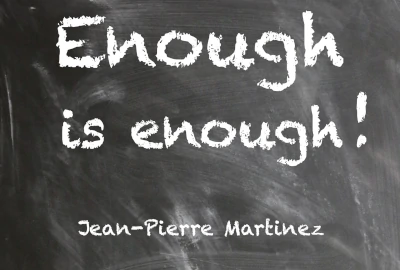A Sketch by Jean-Pierre Martinez
Two characters. They remain silent for a long moment.
One – Too much is too much! That’s enough now!
The other looks at him, slightly surprised.
Two – Uh… Yeah…
One – Don’t you agree?
Two – Yeah, I do…
One – But…?
Two – Nothing, really…
One – You don’t agree with me?
Two – No, I do agree…
One – Come on! You don’t agree with me?
Two – Yes, I do, but…
One – But what?
Two – I think you’re exaggerating a bit, to be honest.
One – Me? Exaggerating?
Two – You’re exaggerating a lot, actually.
One – I’m exaggerating a lot? Me? Just because I said too much is too much?
Two – Yes, I think you’re exaggerating. Way too much…
One – Well damn…
Two – Yeah…
Pause.
One – Wait… How can one exaggerate too much?
Two – Don’t twist my words, okay? I didn’t say you were exaggerating too much, which would be a pleonasm. I said you were exaggerating way too much.
One – How can one exaggerate way too much, when exaggerating too much is already a pleonasm?
Two – Because too much is too much! You either exaggerate or you don’t. You can’t exaggerate too much. It’s categorical and unequivocal. It’s an absolute truth. But exaggerating a little or a lot, or even way too much, is the speaker’s feeling. It’s a relative judgment. And from that personal and subjective perspective, there’s some tolerance for exaggeration.
One – Oh really…?
Two – Take someone from Liverpool, for example; they tend to exaggerate a bit. We tolerate them exaggerating a bit, it’s part of their charm. A person from Liverpool who doesn’t exaggerate enough wouldn’t really be Liverpool-like. But they shouldn’t exaggerate too much either, you see? There’s a limit to exaggeration, after all!
One – Uh… Yeah…
Two – Right.
One – Yet, I just said “too much is too much.”
Two – Yes. But then you added “that’s enough now.” That’s where I think you’re exaggerating a bit. Or even a lot. (Pause) Even for someone from Liverpool…
One – So you think I’m too excessive?
Two – Too excessive, no. That would be another pleonasm. Let’s say rather a bit too much or way too much excessive. Or better yet, very excessive.
One – Very, too… It’s the same, isn’t it?
Two – Are you not hearing what I’m saying? Too much implies exceeding a threshold. It’s binary. You’re either below or above the threshold. On one side or the other of the border. Similarly, “excessive” implies going beyond a norm. That’s why “too much excessive” is a pleonasm.
One – Ah, I see…
Two – “Very,” on the contrary, is a matter of degree. It’s gradual. In summary, you can only be on one side or the other of the boundary, which is why “too much excessive” is pleonastic. But once you’ve crossed the boundaries, you can move away from them to a greater or lesser extent. It’s the idea of “very excessive.”
Pause.
One – Don’t you think you’re exaggerating a bit…?
Two – Apologies, I got carried away.
Fade to black.
All the texts available on this website can be downloaded for free. However, performance rights, which constitute fair compensation for the author’s work, are a legal obligation. Whether you are an amateur or a professional, you must request authorization to perform the play and pay the corresponding royalties for the production.
To get in touch with Jean-Pierre Martinez and ask an authorization to represent one of his works: CONTACT FORM.
A sketch from the collection Enough is enough!
Link to the collection for free download (PDF)

Find all of Jean-Pierre Martinez’s plays on his website:
https://jeanpierremartinez.net
